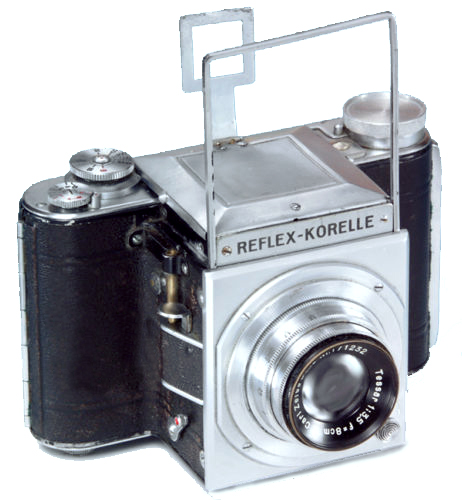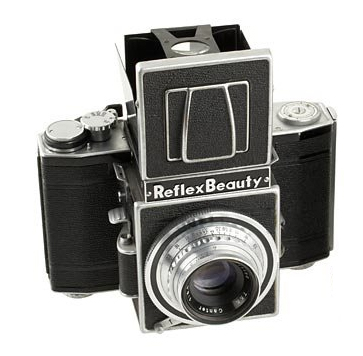by TRA
The History of the Pentacon Six
Reflex Korelle III
 The Reflex Korelle III from about 1939 |
Features
The Korelle III looks strikingly different from the previous Reflex-Korelles, which were covered with black leatherette, apart from a shiny chrome trim. The Model III, however, has a satin chrome finish to “the whole of the camera top, including the reflex hood cover” (“The Korelle Guide”, p 14), and likewise to the lens board at the front of the camera. This model added the top speed of 1/1000, and changed the lens mount to a 56mm diameter bayonet (55mm, according to “The Korelle Guide”, p 14). This permitted the use of “extra long focal length lenses” (“The Korelle Guide”, p 14) without vignetting. Dallmeyer and other lens manufacturers produced long-focus lenses in this mount. However, in 1938 Herr Kochmann, who was threatened by the Nazi régime because of his Jewish faith, had to emigrate from Germany and the government required that the company be transferred to a different owner. From the middle of 1940, the government required the new owner to cease camera manufacture and to use the factory instead to produce materials for the armaments industry. The factory was totally destroyed in the bombing of Dresden on the night of 13th/14th February 1945.
|
| A
Japanese version
Various other manufacturers made cameras that were very closely inspired by the Reflex-Korelle. Among them was Tayodo Koki Co., who made a camera that they called the “Reflex Beauty”. Certain details of the design of the flip-up waist level finder lead one to believe that this camera was produced after 1948, when illustrations of prototypes of the Hasselblad were first published. (The Hasselblad camera that subsequently became known as the 1600F first reached the market in significant numbers in 1950 – see Nordin pp 20-23.) |

|
To go to the Bibliography, click here.
To go on to the next section, click
below.
10 British copies of
the Reflex-Korelle: The Agiflex
To go to the beginning of the history section, click here.
To go to introduction to the cameras, click here.
To choose other options, click below.
Home
© TRA August 2010 Minor revision
(additional information): December 2017